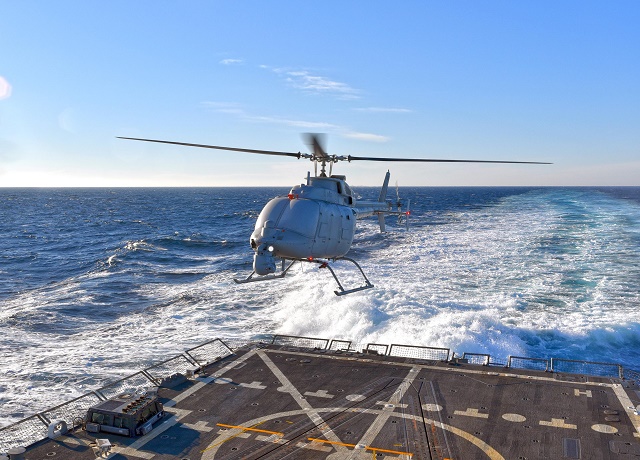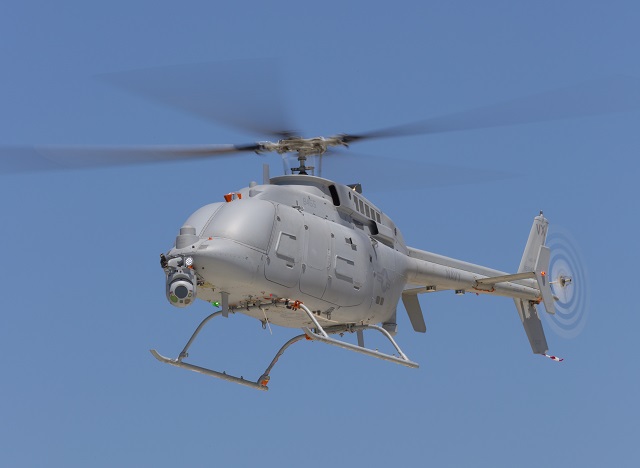The US Navy’s beefed-up unmanned surveillance helicopter, the Northrop Grumman MQ-8C Fire Scout, is on the hunt for a new maritime radar and perhaps even miniaturised missiles, rockets and torpedoes further down the road.
Naval Air Systems Command expects to post a request for proposals for the maritime radar in the week of September 14, and the programme manager for navy and marine corps multi-mission tactical unmanned air systems, Capt Jeff Dodge, expects a strong response from radar providers judging from an industry day held in July.
The radar will enable the Bell 407-based MQ-8C to search and track potential threats across a wide expanse at sea with far greater range and precision than possible through the current sensor suite.
A portion of the early-model Schweizer 330-based Northrop MQ-8B Fire Scout fleet has already been modified to carry the Telephonics AN/ZPY-4 wide-area maritime radar, and Dodge told Flightglobal in a recent interview he expects to competitively select a radar supplier for the MQ-8C by early next year.
It is expected to be a relatively quick integration effort, since the bulk of the mission systems integration work has already been done on the B-model Fire Scout.
“Our survey shows quite a number of existing radars that would fit our requirements,” Dodge says. “They’re out there today, and have the type of maritime capability we’re looking for and would fit on the MQ-8C. We’re looking to pull this off pretty quick.”
It was hoped the RFP would be released by the end of August, but an update on the US government’s contracting website places the release date in mid-September.

The MQ-8C is based on the Bell 407 commercial helicopter and is designed to give navy small surface combatant ships an over-the-horizon ISR capability.
Northrop Grumman
The first operational deployment of the MQ-8C is expected in 2016 and the aircraft will eventually be fully integrated with both variants of Navy’s littoral combat ship, giving them an over-the-horizon, 50nm-radius intelligence, surveillance and reconnaissance capability.
The MQ-8C has far greater speed, altitude and payload than the light-weight MQ-8B and more than double the endurance – about 10 -12h compared to 5.5h.
Twenty-three MQ-8Bs were built prior to the navy switching to the more capable MQ-8C, and 18 are currently equipped to carry the Telephonics radar. Dodge hopes to complete the required structural modifications on all the MQ-8Bs, and then depending on the number of units purchased, the radars will be prioritised to deploying aircraft.
The MQ-8B has been the frontrunner for most of the capabilities the MQ-8C will eventually receive, and that includes the Coastal Battlefield Reconnaissance and Analysis (COBRA) mine-detection sensor suite. The aircraft will also eventually be equipped with the BAE Systems Advanced Precision Kill Weapon System (APKWS) – allowing it to fire 70mm laser-guided rockets.
An ongoing review of the navy’s littoral combat ship could potentially hasten Fire Scout weapons integration efforts, with the service announcing plans in January to up-gun the “small surface combatant,” making it more of frigate.
Dodge doesn’t see the review impacting the Fire Scout mission, except the navy might decide give the littoral combat ship more sting by weaponising the MQ-8C sooner.
“I think what they’ll do is accelerate some of those warfighting capability efforts, or turn those ideas into funded projects as they become more compelling with the desire to put more lethally out there,” the captain says.

BAE System's Advanced Precision Kill Weapon System (APKWS) was demonstrated on the Northrop MQ-8B Fire Scout in June 2013. Perhaps sensing a future business opportunity, BAE Systems test fired the 70mm laser-guided APKWS rockets from a Bell 407 November 2012.
Northrop Grumman
The Fire Scout programme office is evaluating whether it makes sense equip both the B- and C-models to carry weapons, or to focus more on manned-unmanned teaming with the heavily armed Sikorsky MH-60S and MH-60R helicopters deployed on the same ships. The MH-60 is already equipped with a forward-firing gun, Hellfire missiles, APKWS and air-launched torpedoes, but perhaps the more weapon-carriers the better for quick-reaction strikes.
Dodge says the programme office is always looking out for smaller sensors and weapons for its unmanned aircraft, and there are several small research efforts currently examining emerging technologies, but there must be a compelling need for a new programme to start. Instead, Fire Scout is likely to piggyback on larger navy weapon and sensor efforts rather than develop an entirely new product specifically for MQ-8C.
One possibility currently being explored is a miniature torpedo that is being developed to intercept other torpedoes. An air-launched derivative would be an ideal weapon for Fire Scout.
“I just don’t think Fire Scout has a large enough footprint to drive the light-weight torpedo programme by itself. We’re really looking to see where the torpedo programme as a whole is going, and whether we can find one light-weight enough,” says Dodge.
The navy intends to purchase 40 MQ-8Cs initially and 19 are currently on order from Northrop. A full-rate production decision is expected in the third quarter of fiscal 2016, and the initial operational test and evaluation programme is due to start in shortly thereafter.
In August, Northrop demonstrated the aircraft’s 10-hour endurance with a 150nm flight from from Naval Base Ventura County at Point Mugu, California.

Northrop Grumman
Source: FlightGlobal.com



















